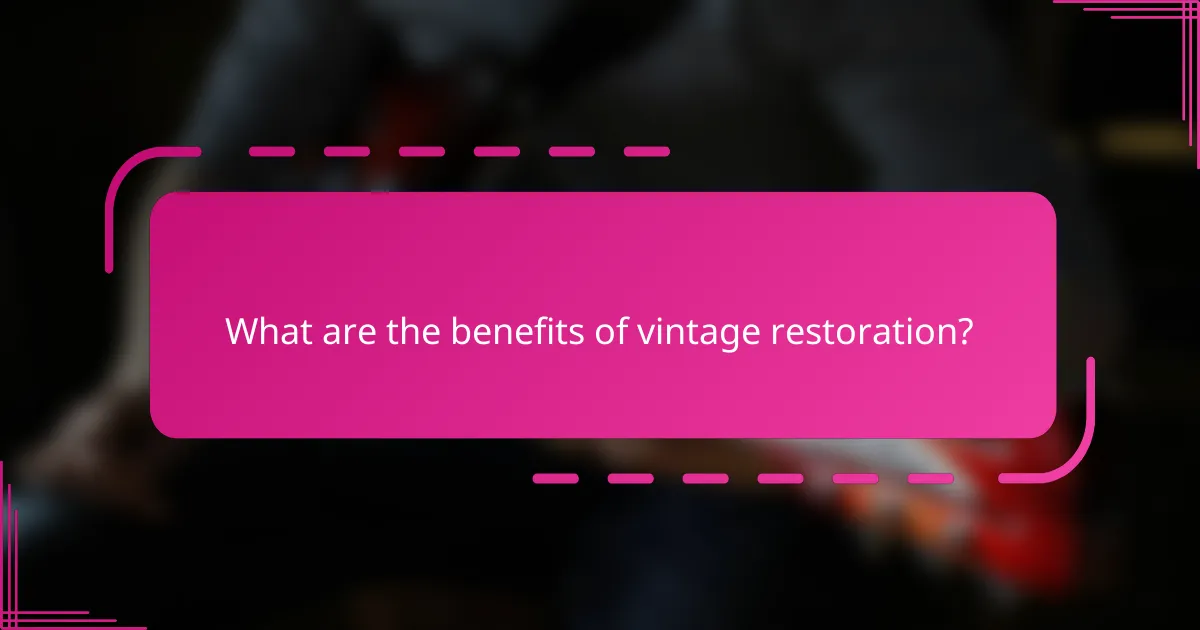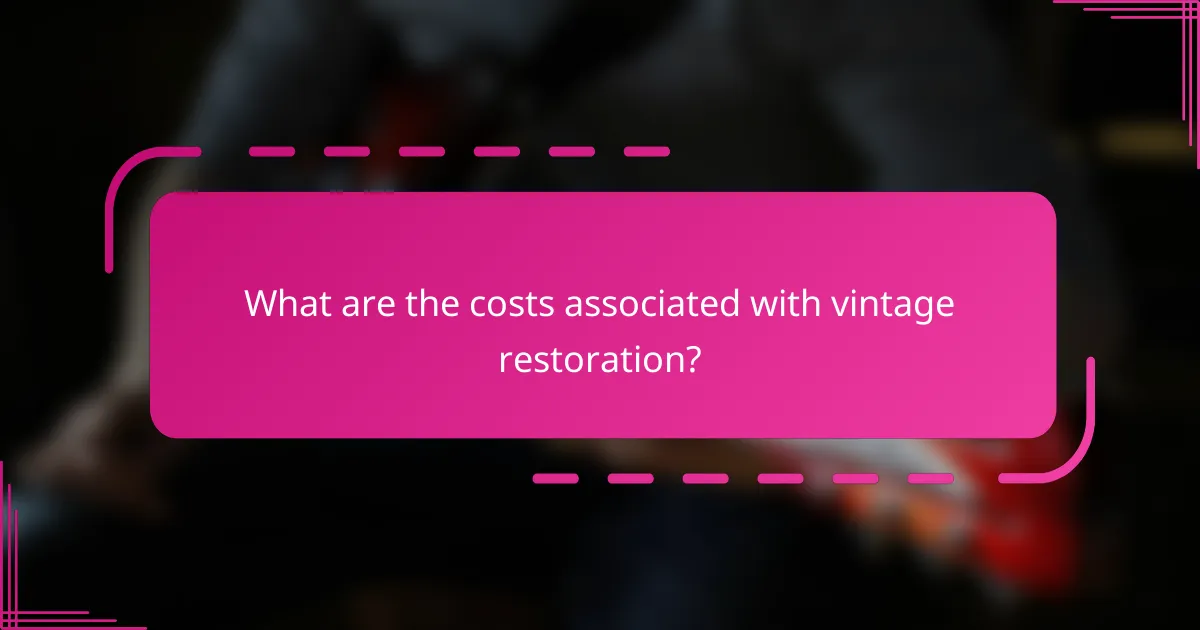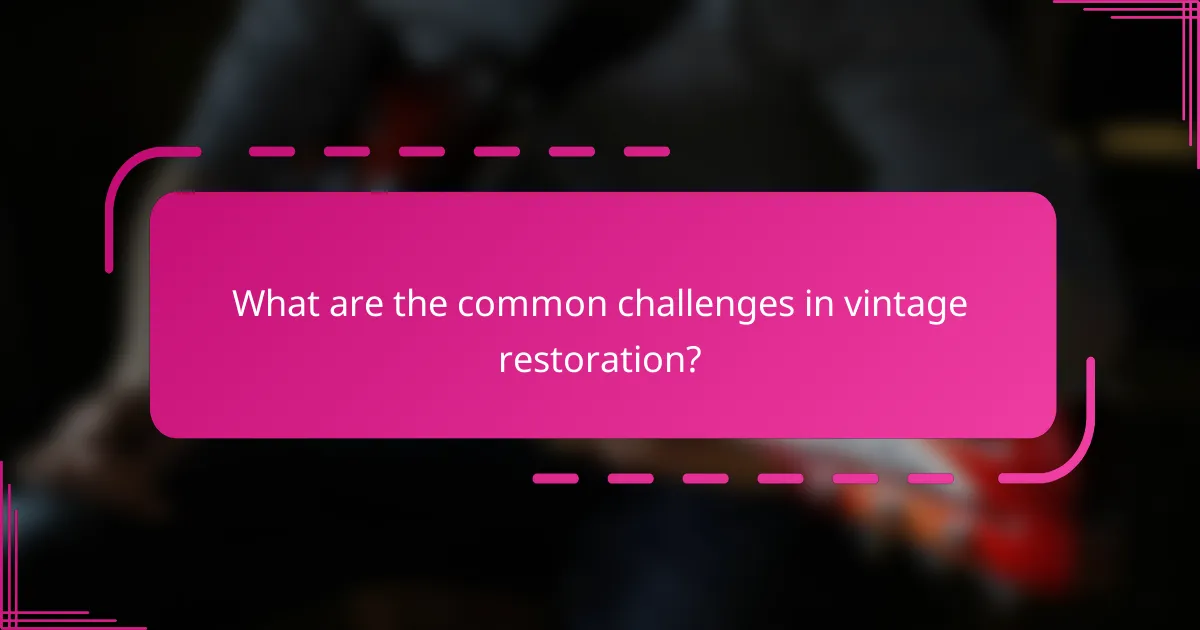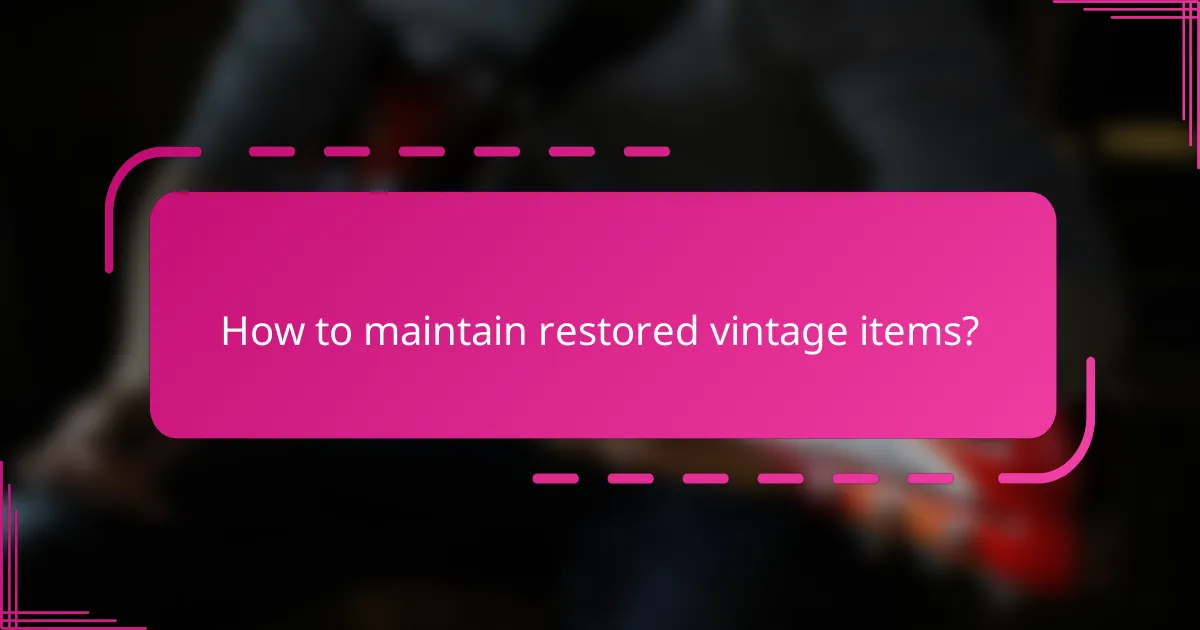Vintage restoration is a meticulous process that not only preserves the historical value of furniture but also enhances its unique character and market appeal. By carefully assessing each piece and selecting appropriate techniques and materials, restorers can breathe new life into items while maintaining their original charm. This investment is particularly valuable for enthusiasts and collectors looking to retain the essence of the past.

How to restore vintage furniture in Los Angeles?
Restoring vintage furniture in Los Angeles involves a careful process that enhances the piece’s original charm while ensuring its functionality. Key considerations include assessing the condition, selecting appropriate techniques, and sourcing materials that align with the vintage aesthetic.
Step-by-step restoration process
The restoration process typically begins with a thorough inspection of the furniture to identify any damage or wear. This includes checking for structural integrity, surface scratches, and any missing parts. Once assessed, you can plan the restoration steps, which may involve cleaning, repairing, refinishing, and reupholstering.
Next, clean the piece using gentle methods to avoid damaging the original finish. For repairs, use wood glue for joints and clamps to hold pieces together while drying. Refinishing may involve sanding down the surface and applying a new coat of stain or varnish to restore its luster.
Essential tools for furniture restoration
Having the right tools is crucial for a successful restoration. Basic tools include screwdrivers, a hammer, clamps, sandpaper, and a paintbrush. A heat gun can be useful for removing old finishes, while a staple gun is essential for reupholstering.
Consider investing in a quality wood glue and a variety of finishes to match the original look of your furniture. A good set of chisels can help with detailed repairs, while a measuring tape ensures precision in your work.
Common materials used in vintage restoration
Common materials for vintage restoration include wood stains, varnishes, and upholstery fabrics that reflect the era of the piece. For wood restoration, look for products that are compatible with the original finish to maintain authenticity.
When reupholstering, choose fabrics that are durable yet true to the vintage style, such as cotton, linen, or leather. Additionally, consider using eco-friendly finishes and adhesives to align with modern sustainability practices while preserving the vintage character.

What are the benefits of vintage restoration?
Vintage restoration offers several advantages, including the preservation of historical value, enhancement of unique character, and increased market appeal. These benefits make it a worthwhile investment for both enthusiasts and collectors.
Preservation of historical value
Restoring vintage items helps maintain their historical significance, ensuring that the stories and craftsmanship of the past are not lost. This process often involves careful research and adherence to original techniques, which can enhance the authenticity of the piece.
Consider documenting the restoration process to provide context and provenance. This can include photographs, receipts, and descriptions of the methods used, which can add to the item’s historical narrative and value.
Enhancement of unique character
Vintage items often possess a distinct character that modern pieces lack, stemming from their age and the materials used. Restoration can enhance these unique features, such as patina or original finishes, making the item more visually appealing while retaining its charm.
When restoring, focus on preserving the original elements that contribute to the piece’s character. Avoid over-restoration, which can strip away the authenticity and diminish its unique qualities.
Increased market appeal
Well-restored vintage items typically attract higher prices in the market due to their rarity and condition. Buyers are often willing to pay a premium for pieces that have been carefully restored, as they represent both an investment and a connection to history.
To maximize market appeal, ensure that the restoration is done professionally and adheres to industry standards. Highlight the restoration efforts in listings, emphasizing the quality of work and the historical significance to attract potential buyers effectively.

What are the costs associated with vintage restoration?
The costs of vintage restoration can vary widely based on the item’s condition, the complexity of the work, and the location of the restoration service. Generally, restoration can range from a few hundred to several thousand dollars, depending on these factors.
Average restoration costs in major cities
In major cities like New York, Los Angeles, and London, restoration costs can be significantly higher due to demand and labor rates. For instance, a simple furniture restoration might start around $300 in smaller towns but could easily exceed $1,000 in urban areas. Similarly, restoring vintage cars can range from $5,000 to over $20,000 depending on the model and extent of work needed.
Factors influencing restoration pricing
Several factors influence the pricing of vintage restoration, including the item’s material, the type of restoration required, and the expertise of the restorer. For example, intricate repairs on antique wood furniture may require specialized skills, thus increasing costs. Additionally, the availability of original parts can affect pricing; sourcing rare components often adds to the overall expense.
Location also plays a crucial role. Restoration services in metropolitan areas typically charge more due to higher overhead costs. It’s advisable to obtain multiple quotes and consider the restorer’s experience and reputation before making a decision.

What skills are needed for vintage restoration?
Vintage restoration requires a blend of technical skills, creativity, and attention to detail. Key abilities include woodworking, upholstery, metalworking, and an understanding of historical materials and techniques.
Essential skills for DIY restorers
DIY restorers should focus on acquiring basic woodworking skills, as many vintage items involve wooden components. Familiarity with tools like saws, sanders, and drills is crucial for making repairs or modifications.
Upholstery skills are also beneficial, especially for restoring furniture. Learning how to reupholster can enhance the aesthetic and comfort of vintage pieces, making them more appealing to buyers.
Additionally, knowledge of paint and finish application is important. Understanding how to properly strip, refinish, or paint surfaces can significantly affect the final look and durability of restored items.
Professional training programs available
Various institutions offer professional training programs in vintage restoration, often focusing on specific skills such as woodworking or upholstery. Community colleges and trade schools typically provide courses that cover essential techniques and safety practices.
Some programs may also include hands-on workshops, allowing students to work on real projects. This practical experience can be invaluable for understanding the nuances of vintage restoration.
For those looking for a more comprehensive education, specialized restoration schools may offer certifications that enhance credibility and marketability in the field. These programs often cover a wide range of topics, including historical research and conservation ethics.

How to choose a vintage restoration service?
Selecting a vintage restoration service involves evaluating their expertise, reputation, and the quality of their previous work. Look for companies that specialize in the type of item you wish to restore, whether it’s furniture, vehicles, or collectibles, to ensure they have the right skills and experience.
Criteria for selecting a restoration expert
When choosing a restoration expert, consider their experience and specialization in vintage items. Check their portfolio for examples of past projects similar to yours, and read customer reviews to gauge satisfaction levels. Additionally, inquire about their restoration techniques and materials to ensure they align with preservation standards.
Another important criterion is the service’s warranty or guarantee on their work. A reputable restoration expert should offer some form of assurance that the restoration will last, which reflects their confidence in the quality of their craftsmanship.
Top-rated vintage restoration companies
Some of the top-rated vintage restoration companies include those recognized for their craftsmanship and customer service. For instance, companies like Restoration Hardware and Classic Car Restorations are well-regarded in their respective fields. They often provide detailed consultations and transparent pricing, which is essential for making informed decisions.
Additionally, local businesses may offer specialized services tailored to your area. Researching regional restoration companies can yield hidden gems that provide personalized service and a deep understanding of local vintage items. Always compare at least three options before making a final choice to ensure you find the best fit for your restoration needs.

What are the common challenges in vintage restoration?
Common challenges in vintage restoration include identifying original materials and addressing structural damage. These issues require careful consideration to maintain the authenticity and integrity of the piece while ensuring it remains functional and appealing.
Identifying original materials
Identifying original materials is crucial for preserving the historical value of vintage items. This process often involves researching the specific era and style of the piece, as well as examining any visible markings or characteristics that indicate the materials used.
Common materials in vintage restoration include wood, metal, glass, and textiles. For instance, knowing whether a piece is made from solid oak or a less expensive wood can significantly affect its value and restoration approach. When in doubt, consulting with experts or using material identification guides can be beneficial.
Dealing with structural damage
Structural damage can compromise the integrity of vintage items, making it essential to address these issues carefully. Common types of structural damage include cracks, breaks, and warping, which may require specialized repair techniques to restore the item without compromising its authenticity.
When dealing with structural damage, consider the extent of the repair needed. Minor cracks might be filled with epoxy, while more significant breaks may require rejoining or reinforcing the original structure. Always prioritize methods that preserve the original materials and craftsmanship, as this will enhance the item’s historical value.

How to maintain restored vintage items?
Maintaining restored vintage items involves regular care to preserve their unique character and historical value. Proper maintenance ensures longevity and enhances market appeal, making it essential for collectors and enthusiasts alike.
Best practices for care and maintenance
To care for restored vintage items, start with a clean environment. Dust regularly using a soft, lint-free cloth to prevent buildup that can damage surfaces. Avoid using harsh chemicals; instead, opt for gentle cleaners specifically designed for the material of your item.
Temperature and humidity control are crucial. Store items in a climate-controlled space to prevent warping or deterioration. Ideal conditions typically range from 20-22°C (68-72°F) with humidity levels around 40-50%.
Regular inspections can help catch early signs of wear or damage. Look for loose joints, fading colors, or any signs of pests. Addressing these issues promptly can prevent more extensive repairs and maintain the item’s value.
